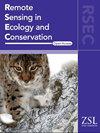垂直方向相机陷阱野生动物密度估计的随机相遇模型
IF 4.3
2区 环境科学与生态学
Q1 ECOLOGY
引用次数: 0
摘要
随机遭遇模型(REM)通过校正动物的一组生物变量(平均群体大小、速度和活动水平)和相机传感器的特征的捕获率,从相机陷阱数据中估计动物密度。REM被广泛用于将摄像机安装在树木或其他与地面平行的结构上。在这里,我们修改了REM公式,以适应垂直定向相机陷阱获得的另一种视野,这是一种用于避免相机被盗和损坏的部署类型。我们展示了如何通过微小的修改来调整计算以适应不同的检测区域。我们发现有效检测区域可以接近于一个矩形,其大小受摄像机运动传感器菲涅耳透镜的特性、不同物种的体重和摄像机高度的影响。其他REM参数保持不变。我们将改进后的快速眼动(vREM)应用于尼泊尔巴迪亚国家公园垂直定向相机陷阱收集的野生动物数据。我们进一步验证了使用最大似然估计的相机模型的有效检测区域最好近似为矩形。密度估计结果与先前在巴迪亚进行的9个物种的独立密度估计大致相符,这些物种的体型大小各不相同,相差4个数量级。我们得出的结论是,这些修改允许快速眼动有效地用于哺乳动物密度估计物种具有广泛的身体大小,垂直定向相机陷阱。本文章由计算机程序翻译,如有差异,请以英文原文为准。
A random encounter model for wildlife density estimation with vertically oriented camera traps
The random encounter model (REM) estimates animal densities from camera‐trap data by correcting capture rates for a set of biological variables of the animals (average group size, speed and activity level) and characteristics of camera sensors. The REM has been widely used for setups in which cameras are mounted on trees or other structures aimed parallel to the ground. Here, we modify the REM formula to accommodate an alternative field of view acquired with vertically oriented camera traps, a type of deployment used to avoid camera theft and damage. We show how the calculations can be adapted to account for a different detection zone with minor modifications. We find that the effective detection area can be close to a rectangle with dimensions influenced by the properties of the Fresnel lens of the camera's motion sensor, the body mass of different species and the height of the camera. The other REM parameters remain the same. We tested the modified REM (vREM) by applying it to wildlife data collected with vertically oriented camera traps in Bardia National Park, Nepal. We further validated that the effective detection area for the camera model used was best approximated as a rectangle shape using maximum likelihood estimation. Density estimates obtained broadly matched independent density estimates for nine species from the previous studies in Bardia with varying body sizes by four orders of magnitude. We conclude that these modifications allow the REM to be effectively used for mammal density estimation for species with a wide range of body sizes, with vertically oriented camera traps.
求助全文
通过发布文献求助,成功后即可免费获取论文全文。
去求助
来源期刊

Remote Sensing in Ecology and Conservation
Earth and Planetary Sciences-Computers in Earth Sciences
CiteScore
9.80
自引率
5.50%
发文量
69
审稿时长
18 weeks
期刊介绍:
emote Sensing in Ecology and Conservation provides a forum for rapid, peer-reviewed publication of novel, multidisciplinary research at the interface between remote sensing science and ecology and conservation. The journal prioritizes findings that advance the scientific basis of ecology and conservation, promoting the development of remote-sensing based methods relevant to the management of land use and biological systems at all levels, from populations and species to ecosystems and biomes. The journal defines remote sensing in its broadest sense, including data acquisition by hand-held and fixed ground-based sensors, such as camera traps and acoustic recorders, and sensors on airplanes and satellites. The intended journal’s audience includes ecologists, conservation scientists, policy makers, managers of terrestrial and aquatic systems, remote sensing scientists, and students.
Remote Sensing in Ecology and Conservation is a fully open access journal from Wiley and the Zoological Society of London. Remote sensing has enormous potential as to provide information on the state of, and pressures on, biological diversity and ecosystem services, at multiple spatial and temporal scales. This new publication provides a forum for multidisciplinary research in remote sensing science, ecological research and conservation science.
 求助内容:
求助内容: 应助结果提醒方式:
应助结果提醒方式:


